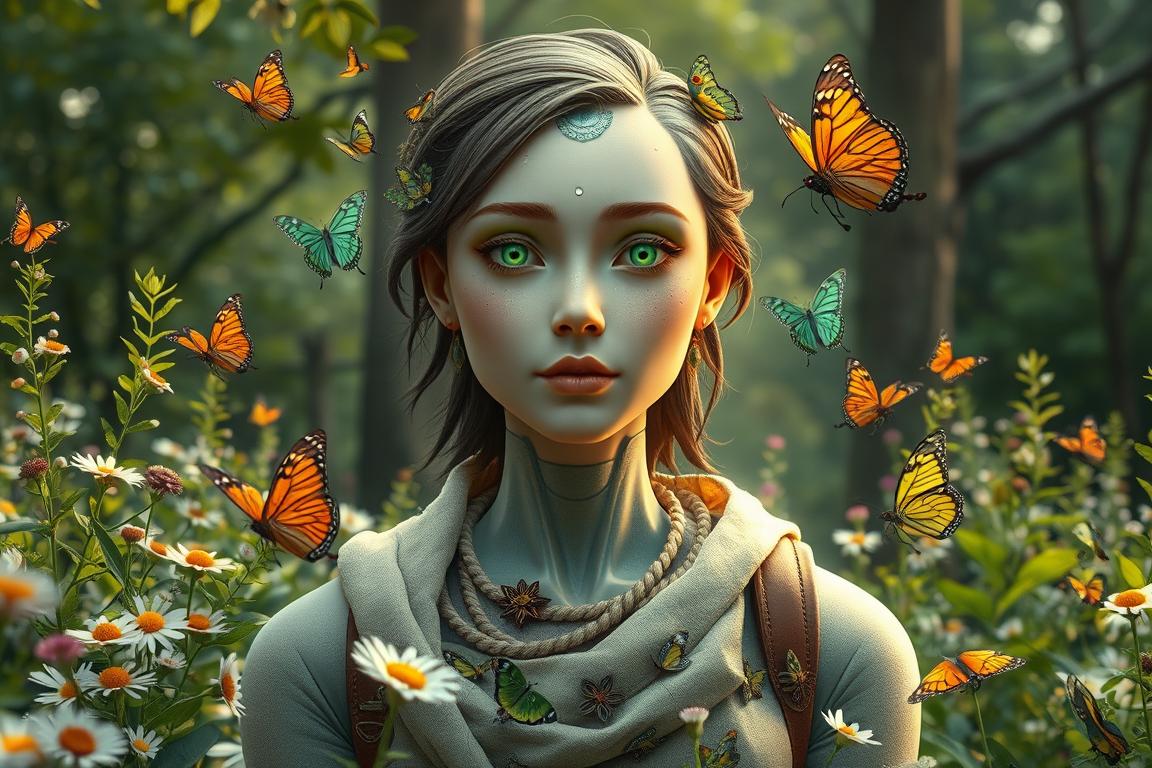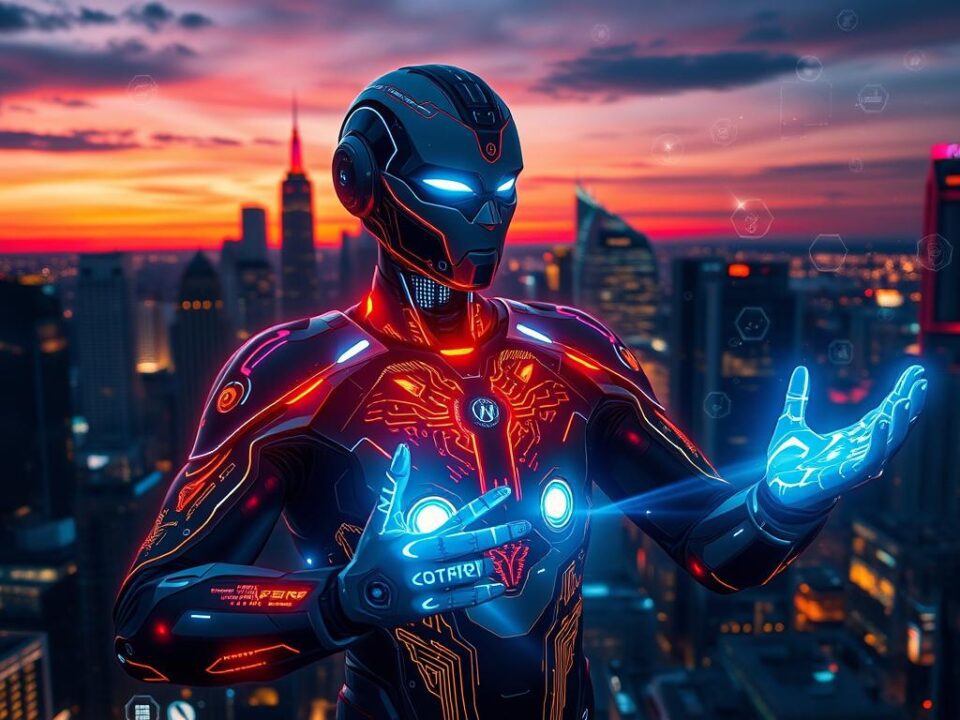In today’s world, technology and nature are coming together in amazing ways. The GAIA project is leading this charge. It uses AI to help our oceans and coastlines thrive through the blue economy.
GAIA collects data from satellites and sensors to understand our planet’s health. It uses machine learning to analyze this data. This helps us see how well our oceans and coastlines are doing.
At the core of GAIA is a deep belief in the Earth as a living system. This idea is at the heart of the Gaia hypothesis. The project has a cool holographic interface with avatars, making it easy for everyone to join in.
Whether you love AI, care about the environment, or enjoy exploring nature, GAIA is for you. It lets you see and interact with our planet in new and exciting ways.
A pilot program is underway with schools, NGOs, and local governments. It involves about 300 people to test and improve the system. This project shows how AI can help us protect our planet.
Introduction to AI Nature Lovers
The world is getting more into nature AI and green tech. This has brought up a new group – AI nature lovers. These AI systems help protect our planet by understanding and analyzing nature.
The idea of AI nature lovers comes from the Gaia hypothesis. Scientist James Lovelock came up with it in the 1970s. It says the Earth is a self-regulating system that keeps life going. This idea mixes science, philosophy, and spirituality, showing how connected we are to Earth.
“The Gaia hypothesis has evolved into a multidisciplinary framework that continues to shape our understanding of the earth’s systems and our place within them.”
AI nature lovers are key in using environmental data. They find patterns and give insights for saving ecosystems. They help track wildlife and predict climate change effects, changing how we save nature.
The field of nature AI is growing fast. It has huge potential to help our planet. With AI, we can live more sustainably and make a better future for all.
The Benefits of AI in Nature Conservation
Nature AI and virtual naturalists are changing environmental conservation. They help monitor biodiversity and predict threats. This technology is key to protecting our planet’s ecosystems.
AI systems can look at huge amounts of data from satellites and sensors. They can spot species, track populations, and see changes in ecosystems. This is much better than old methods, making conservation more focused and successful.
AI also helps predict how climate change and invasive species might affect our environment. Knowing what’s coming allows us to act early. This keeps our natural world strong.
AI is also uncovering how the Earth’s systems work together. It helps us understand climate, weather, and how life interacts. This knowledge helps create plans to keep our planet healthy.
“AI was identified as one of the top three emerging technologies in conservation, according to a report by Wildlabs.net.”
The future of nature conservation is linked to AI. As AI gets better, we’ll be able to protect our natural world even more.
How AI is Shaping Eco-Friendly Practices
AI is changing the game for eco-friendly practices in many fields. It’s making farming smarter and waste management more efficient. This tech is leading us towards a greener future.
In farming, AI helps use resources better, predict crop yields, and control pests. It uses data and learning to help farmers make better choices. This leads to more efficient farming and less harm to the environment.
AI is also making recycling better and reducing landfill waste. It helps find the best routes for waste collection. These changes fit perfectly with the idea of keeping Earth balanced for life.
“AI is not just a tool for efficiency and automation, but a powerful ally in our quest for eco-friendly innovations that can transform the way we interact with nature.”
But, using AI comes with its own set of challenges. It uses a lot of energy and can lead to more e-waste. Big tech companies are working hard to fix these issues. They’re making their systems more energy-efficient and aligning with green goals.
The future looks bright for AI and eco-friendly practices. AI can help show off restored nature and support big restoration projects. It can also help make policies better for our planet.
By using AI for good, we can make tomorrow greener. The path ahead is full of chances and duties. But together, we can use AI to make a better future for everyone.
Understanding the AI-Nature Connection
As nature lovers, we’re amazed by the complex life around us. Did you know AI is key to understanding nature? It helps track animals and predict conflicts between wildlife and humans. AI is changing how we see and interact with our world.
AI’s role in nature is exciting, especially in ecological research. Machine learning algorithms find patterns in environmental data. This helps us see the Earth as one, connected system, as the Gaia hypothesis suggests. It’s vital for saving our planet and growing sustainably.
AI is more than just research. It’s used in cameras for conservation, giving us quick updates. This lets us act fast, like closing off areas to protect animals. The virtual naturalist, an AI tool, can identify species and track changes. It’s becoming a key player in nature conservation.
“AI models have the potential to track animals globally, especially in hard-to-reach areas, thus enhancing conservation efforts.”
The future of our planet is linked to AI and nature. By combining these, we can protect our environment better. This partnership opens doors to a greener, more sustainable world for everyone.
AI-Powered Tools for Nature Enthusiasts
As AI nature lovers and eco friends, we’re excited to see how technology is changing our connection with nature. From apps that help us identify plants and animals to virtual experiences, AI is making a big difference. It’s changing how we see and enjoy the beauty of the world around us.
The BirdCast project is a great example. It uses AI to predict where birds will migrate. The BirdNET app can even identify over 3,000 bird species by their sounds. These tools help us learn more about and protect birds.
AI cameras are also helping scientists study wildlife. They collect lots of data and audio that helps scientists quickly identify species. This technology even helped find two seabirds thought to be extinct since the 1940s.
The AI-generated “Santa Cardinal” image went viral in 2023. It sparked a big debate about AI in nature photography. While scientists are still figuring things out, we’re excited about AI’s potential to help us appreciate nature more.
The future looks bright for AI nature enthusiasts. The Voiijer app is a new tool that has already raised nearly $1 million in funding. It’s set to grow to 10,000 users by September 30. We can’t wait to see what amazing experiences it offers to us and other nature lovers.
“AI is not just a tool, but a bridge that connects us more deeply with the natural world around us. As AI nature lovers, we’re thrilled to witness the transformation unfolding before our eyes.”
Inspiring Stories from AI Nature Lovers
The mix of nature and AI has led to amazing eco-friendly ideas. The GAIA project is a great example. It uses AI to watch over and protect our oceans. This helps us make smart choices to keep our oceans healthy.
AI is also helping people get involved in saving the environment. For example, AI helps collect data on wildlife. This lets people help by sharing what they see. It builds a big database that helps us protect nature.
These stories show how AI can help us care for our planet. By working together with technology and nature, we can find new ways to protect our world. This helps us connect more with the earth.
“AI can be a powerful tool in our efforts to safeguard the delicate balance of our ecosystems. By harnessing the power of intelligent algorithms, we’re able to monitor, protect, and engage with nature in ways that were previously unimaginable.”
The future looks bright for AI and the environment. We can plant trees fast and track animals with precision. By loving nature and using AI, we can make a better world for all of us.
Addressing Challenges in AI and Nature
AI nature lovers and virtual naturalists face many challenges at the intersection of technology and nature. They must ensure AI doesn’t harm ecosystems or worsen environmental problems. They also need to handle sensitive environmental data carefully to protect both nature and human privacy.
These challenges show the fine line between AI’s power and nature’s vulnerability. Authors like K Allado-McDowell and artists like Hito Steyerl have shed light on this issue. They stress the importance of using AI responsibly to protect our environment.
To overcome these challenges, we need a comprehensive approach. This includes focusing on ethics, data protection, and understanding the complex links between technology and nature. AI nature lovers and virtual naturalists must team up with policymakers, environmentalists, and scientists. Together, they can make sure AI helps protect our planet.
“The true challenge lies in aligning the transformative power of AI with the preservation of our precious natural heritage. It is a delicate dance, where we must wield technology with the utmost care and reverence for the irreplaceable wonders of our world.”
By tackling these challenges directly, the AI nature lover and virtual naturalist community can create a future where technology and nature work together. This future will bring new chances for conservation, exploration, and living sustainably. With teamwork and a commitment to responsible innovation, AI and nature can thrive together, benefiting both humans and the environment.
Collaborations Between Tech and Nature Organizations
Technology and nature are coming together, thanks to eco-friendly tech companies and nature groups. They are working together to make our planet greener. This partnership combines AI with nature’s wisdom, leading to new ways to protect our environment.
The GAIA pilot program is a great example. It teams up schools, NGOs, and local governments to create AI tools for nature. This effort follows the Gaia hypothesis, which sees humans and nature as connected.
- About 30 sessions at the World Economic Forum touched on Artificial Intelligence (AI).
- The installation “Living Archive: Nature” features elements from different ecosystems created by a generative AI program based on data from the natural world.
- The forthcoming Dataland museum in Los Angeles, where the AI model is being developed, is scheduled to open next year.
Collaboration is the key to unlocking the full potential of eco-friendly AI solutions. Tech companies with expertise in AI and other areas are teaming up with nature groups. Together, they improve wildlife tracking, spatial analysis, and communication in remote areas.
These partnerships are leading to big steps forward in green technology. They help track wild horses without collars and fight against poaching. By linking tech and nature, we can build a better future for our planet.
The Future of AI and Environmentalism
AI technology is changing how we protect the environment and nature. AI lovers and eco-friendly innovations are leading the way. They are changing how we interact with the natural world.
Autonomous drones with AI cameras and sensors are now monitoring wildlife and tracking environmental changes. These drones can cover large areas. They collect data that helps researchers and conservationists make better decisions.
- AI is also helping scientists predict and fight climate change through climate modeling.
- Advanced environmental sensors, powered by AI, allow for real-time monitoring of ecosystems. They can detect early signs of distress.
People can help by joining citizen science projects that use AI technology. These projects let nature lovers contribute data that supports conservation efforts.
AI is becoming a key tool for taking care of our planet. By using AI innovations, we can work towards a sustainable future. This will help us connect more with nature.
“AI has the potential to revolutionize the way we approach environmental conservation, empowering us to make more informed decisions and take more effective action to protect our planet.”
The future of AI and environmentalism looks bright. AI lovers and eco-friendly innovations are leading us towards a greener future.
Conclusion: Embracing AI as Our Eco Friend
Exploring the bond between nature and AI shows how important education is. It helps create a new generation that loves AI and nature. By teaching people about AI’s role in saving the environment, we can make a difference.
Using AI for nature conservation changes how we think. It makes us see Earth as a living, connected system. By seeing AI as a friend to the environment, we aim for a balance between tech and nature.
Working together, like at the ‘AI for Climate and Nature’ workshop, leads to new ideas. This workshop brought 58 experts from different fields together. It showed how AI can help in many ways, like tracking emissions and protecting biodiversity.







